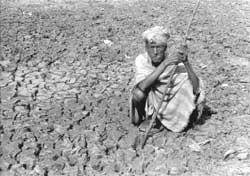Parched lands
 This year Orissa suffered one of its worst droughts as well. The drought gripped more than two-thirds of the state's districts. After the great famine of 1866, it was for the first time that drought of such a magnitude hit Orissa. It affected the lives of 11 mil-lion people.
This year Orissa suffered one of its worst droughts as well. The drought gripped more than two-thirds of the state's districts. After the great famine of 1866, it was for the first time that drought of such a magnitude hit Orissa. It affected the lives of 11 mil-lion people.
After flood, drought is the second most frequent calamity that the state faces. The state government has offi-cially declared 25 districts as drought prone. Drought has a chronic reccu-rence since 1965 in west Orissa. "Since 1965 there is not a single year when this region has not seen drought,' says Jagdish Pradhan of Sahabhagi Vikas Kendra, an NGO working on long-term drought mitigation.
But it is not only the recurrence but the expanse of the drought that haunts Orissa. The 2001 drought engulfed dis-tricts like Sundergarh and the Kendra-pada which were earlier drought-free. The state government's white paper on the 2001 drought, the third consecutive white paper on drought, admitted its uncontrolled spread. By February, 2001, Orissa's western districts were reeling under a severe water crisis and people started migrat-ing. The worst affected districts like Kalahandi and Balangir reported 60 per cent less rainfall than normal. The situa-tion in the nine western districts was severe as it was the second consecutive drought. The state government put the economic loss due to crop damage at Rs 642.89 crore. By May, 2001, the state had already reported 61 starvation deaths. But the government has admit-ted only 19 deaths which too it said were induced by poverty.
As the drought gripped the coastal districts, where the agricultural labourers of west Orissa migrate traditionally, peo-ple had to jostle to get some work under drought relief operation. The jobs pro-vided under the operation could cater hardly to 10 per cent of the affected peo-ple. The Orissa government claimed that this was its largest relief operation in recent history but unofficial estimates indicated that more than half a million people had to migrate to neighbouring states in search of work. Surveys in Balangir and Kalahandi show that with every drought, people lose a substantial part of their land to moneylenders.
Orissa has become more vulnerable to drought though there has been only a negligible deficiency in rainfall. The drought history of the state, during the 1950s, indicates that only three districts were affected. But by 1980s, the entire western Orissa was drought-affected and by 1990s, southern Orissa also had come under the grip of drought.
One of the prime reasons for increa-sed frequency of drought is the neglect of Orissa's traditional water harvesting structures. For instance, the drought-prone Kalahandi-Balangir-Koraput (KBK) districts of western Orissa. Four decades ago, these districts combated droughts successfully with a network of about 20,000 traditional tanks built with community participation. Given the undulating topography of this region, these tanks stored water which was used during the dry months. So a failure in rainfall never caused drought.
What has also aggravated the dro-ught situation in these districts is the disappearance of drought-resistant indigenous crop varieties. A study by Paschim Orissa Krishijivi Sangh (POKS), a farmers' organisation based in Kala-handi, says that the indigenous varieties of crops are on the verge of extinction in western Orissa as high yielding varieties (HYV) are encouraged for commercial use. In the early 1960s, the reputed agri-cultural scientist, R C Richaria, had identified as many as 300 varieties of paddy seeds, which the farmers of wes-tern Orissa were cultivating. In 1996, the varieties reduced to just 71.
In the last 100 years, 30 severe drou-ghts have been recorded in Orissa. But the government has not learnt anything. Skewed policies have led to the death of traditional water harvesting structures. Drought proofing rather than drought relief is the need of the hour. But is the government listening?
Related Content
- Climate change means more rain but less water in rural rivers: Study
- In Madagascar, mothers weep and send their children to bed without water to drink
- Solar power: Harnessing the sun to water fields
- Southern California wildfire spreads as blazes hit parched states
- Farmers spending a fortune on borewells in parched Marathwada
- World food prices jump 10% in July: World Bank
